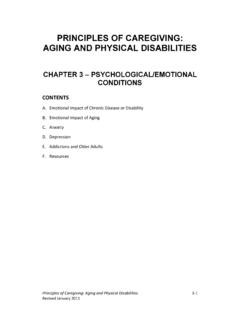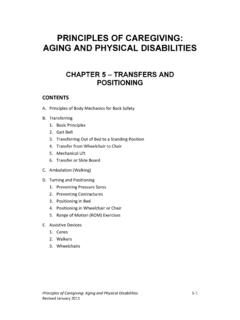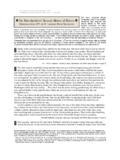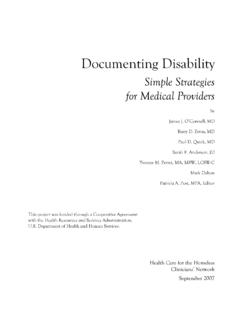Transcription of PRINCIPLES OF CAREGIVING: FUNDAMENTALS
1 PRINCIPLES of caregiving : FUNDAMENTALS 6-1 Revised January 2011 PRINCIPLES OF caregiving : FUNDAMENTALS CHAPTER 6 OBSERVING, REPORTING AND documenting CONTENTS A. Purpose and Importance of Observing and Reporting B. Observing and Monitoring 1. Recognizing Changes The DCW as Detective 2. Signs and Symptoms of Illness and Injury 3.
2 Changes in Mental or Emotional Status 4. Changes in Home Environment C. Care Plans and Support Plans D. Reporting E. documenting 1. Significance of Documentation 2. Documentation Guidelines 3. documenting and Reporting Facts 4. Documentation Activity 5. Standardized Medical Abbreviations and Acronyms Chapter 6 Observing, Reporting and documenting PRINCIPLES of caregiving : FUNDAMENTALS 6-2 Revised January 2011 OBJECTIVES 1.
3 Explain the purpose of reporting and documentation. 2. Describe the purpose of care and support plans. 3. Explain the importance of observing changes in a person and describe observation techniques. 4. Identify and explain signs and symptoms that need to be reported. 5. Prepare written documentation following documentation guidelines. KEY TERMS Care plan Sign Charting Reporting Documentation Support plan Progress notes Symptom Chapter 6 Observing, Reporting and documenting PRINCIPLES of caregiving .
4 FUNDAMENTALS 6-3 Revised January 2011 A. PURPOSE AND IMPORTANCE OF OBSERVING AND REPORTING The purpose of observing, reporting, and documenting is to communicate any changes or status that may be occurring with an individual and/or the family. Since the individual may even be unaware of changes, it is vitally important for the DCW to communicate with other team members (including the person s family, as appropriate).
5 This can be accomplished through observing and monitoring for any changes, and reporting and documenting those changes. Report and document only things that you saw or did YOURSELF. The information that is communicated will help the supervisor act appropriately. The DCW becomes the eyes and ears for the supervisor. The DCWs accurate input is vitally important. B. OBSERVING AND MONITORING 1. Recognizing Changes The DCW as Detective Early identification of changes in an individual s daily routines, behavior, ways of communicating, appearance, general manner or mood, or physical health can save his or her life.
6 You get to know a person by spending time with him or her and learning what is usual for them. If you don t know what is normal for a person, you won t know when something has changed. Tools the DCW may use Observation: Use all of your senses: sight, hearing, touch and smell. Communication: Ask questions and listen to answers. A good listener hears the words and notices other ways of communicating, including behavior. 2. Signs and Symptoms of Illness or Injury Signs are what can be observed; symptoms are what the person experiences or feels.
7 Physical Health: Changes in physical health are often identified by changes in a particular part of the body. Some are changes you may observe, and others are changes an individual may tell you. For example, you may observe that an individual is pulling his ear or an individual may tell you that his ear hurts. Ask yourself: Is there any apparent change to the individual s skin, eyes, ears, nose, or any other part of the body? Chapter 6 Observing, Reporting and documenting PRINCIPLES of caregiving : FUNDAMENTALS 6-4 Revised January 2011 Physical changes to pay attention to include: Skin: Redness, cut, swelling, rash.
8 Eyes: Redness, yellow or green drainage, swelling of the eyelid, excessive tearing, or the individual reports pain and/or that eyes are burning. Ears: Pulling at ear, ringing in the ears, redness, fever, diminished hearing, and drainage from the ear canal, the individual reports dizziness or pain. Nose: Runny discharge (clear, cloudy, colored), rubbing of nose. Mouth and throat: Refusing to eat, redness, white patches at the back of the throat, hoarse voice, fever or skin rash, toothache, facial or gum swelling, gum bleeding, fever, individual reports pain when swallowing.
9 Muscles and bones: Inability to move a leg or an arm that the individual could previously move, stiffness, limited range of motion, individual reports pain in the arms, legs, back. Breathing (lungs): Chest pain, cough, phlegm (mucous), shortness of breath or wheezing, fever, rash, stiff neck, headache, chills, nasal congestion, individual reports pain in nose or teeth, dizziness. Heart and blood vessels: Numb or cold hands or feet, swelling of ankles, chest pain, shortness of breath.
10 Abdomen, bowel, and bladder (stomach, intestines, liver, gallbladder, pancreas, urinary tract): Constant or frequent abdominal pain, bloating, vomiting, loose stools or diarrhea, constipation, blood in vomit or stools, fever, fruity smelling breath, difficult, painful and/or burning urination, changes in urine color (clear to cloudy or light to dark yellow), fruity smelling urine, nausea, pain on one or both sides of the mid-back, chills. Women s health: Vaginal discharge, itching, unusual odor, burning, changes in menses, such as change in frequency, length, and flow.














